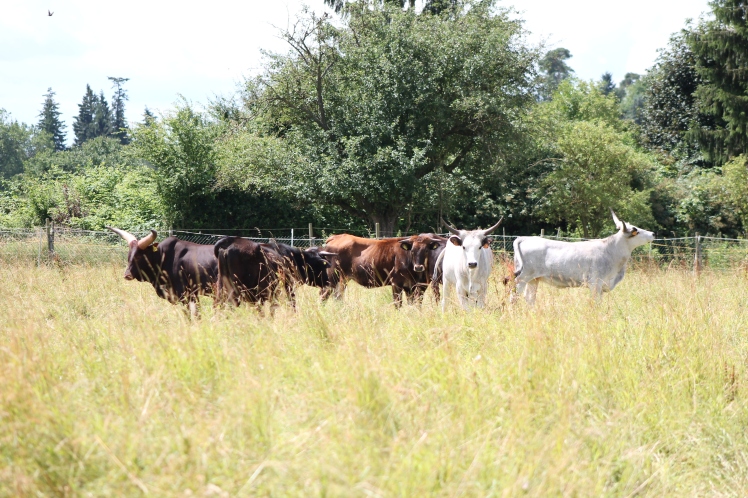Heck x Chianina bulls had a diluted fur colour as well, but to varying extent. Leonardo, the half-Chianina bull that was sold to Denmark, had a light colour saddle but had black-coloured areas too. Luca, a half-Chianina bull that was covered here extensively already, was mostly coloured in dark brown with much beige areas (mind that winter coat is always darker than summer coat in cattle).
So we would expect a Sayaguesa x Chianina bull to have a colour similar to that of Heck x Chianina bulls. In 2014, I was sent a photo of a young bull of that combination by Matthias Scharf. That individual was of a greyish tone and more diluted than the cows of the same combination, and even way more diluted than the half-Heck bulls. This was surprising to me, especially since the colour of Sayaguesa seemed to be more intense and dominant in crossbreeds with Heck. The bull was slaughtered because of its colour and the tiny horn in autumn of the same year.
Nevertheless, while searching through my Lippeaue photo archive I was provided by Matthias Scharf, I discovered another young Sayaguesa x Chianina bull. Its number was 42 624 (born 2010, dispeared from the stock list after 2012), and like Bionade its parents were Churro and Eloisa, so they where fullblood siblings. Interestingly, this bull's coat colour was not diluted at all, it even had only a very faint saddle that was not visible in its winter coat and might have gotten outgrown if it would have reached full age.
The photos show him at the age of one (uppermost) and two years. As you see, the horns of this individuals were still meagre, but that is simply what you get from that combination. It seems that its hump was not that developed as in its grey coloured halfblood brother of the same combination, but it was still high on the legs at this age at least. I don't know whether 42 624 was slaughtered or sold alive, in any way it was not kept in the herd.
Whether or not this bull might have grown tall or well-shaped, it shows two facts: 1) looking at just one individual of a breed combination is by far not enough to judge the potential in it, especially for F1 individuals, which are, after all, genetically of little relevance; 2) there is potential for accurately coloured Sayaguesa-Chianina crosses even in the first generation. Combining those two breeds might result in very useful animals for further breeding in being large, tall, muscular and well-shaped, with a good skull shape and colour. But of course the whole spectrum from that to disappointing is possible, and most results would be inbetween. In any case, if 42 624 would have been kept for a few years more he might have produced interesting results with his (half-blood-)sisters of the same combination. However, I understand that this animal was removed because of the negative influence on horn shape and size it might have had since its horns are far away from the breeding objective.
As I recently reported, the Auerrindprojekt is now planning to produce some animals of that combination. Maybe we are going to see some F2 Sayaguesa-Chianina in the future. Of course either large quantity or simply luck is needed to unite the full potential of both breeds within early cross generations.











